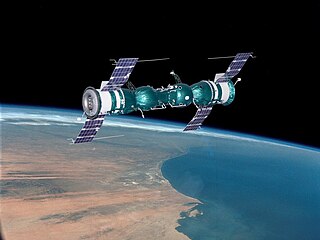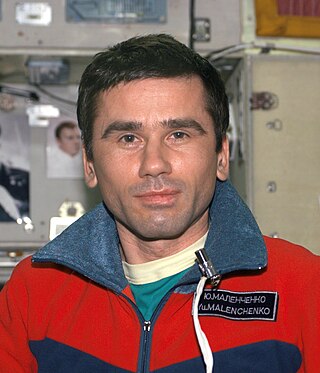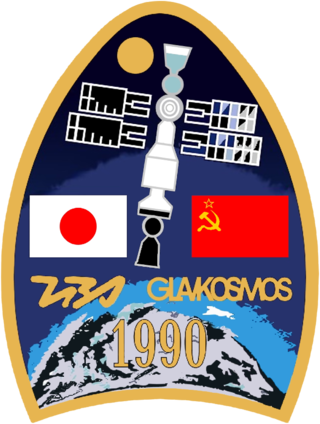
Mir was a space station that operated in low Earth orbit from 1986 to 2001, operated by the Soviet Union and later by Russia. Mir was the first modular space station and was assembled in orbit from 1986 to 1996. It had a greater mass than any previous spacecraft. At the time it was the largest artificial satellite in orbit, succeeded by the International Space Station (ISS) after Mir's orbit decayed. The station served as a microgravity research laboratory in which crews conducted experiments in biology, human biology, physics, astronomy, meteorology, and spacecraft systems with a goal of developing technologies required for permanent occupation of space.

Soyuz is a series of spacecraft which has been in service since the 1960s, having made more than 140 flights. It was designed for the Soviet space program by the Korolev Design Bureau. The Soyuz succeeded the Voskhod spacecraft and was originally built as part of the Soviet crewed lunar programs. It is launched on a Soyuz rocket from the Baikonur Cosmodrome in Kazakhstan. Between the 2011 retirement of the Space Shuttle and the 2020 demo flight of SpaceX Crew Dragon, the Soyuz served as the only means to ferry crew to or from the International Space Station, for which it remains heavily used. Although China did launch crewed Shenzhou flights during this time, none of them docked with the ISS.

Soyuz 5 was a Soyuz mission using the Soyuz 7K-OK spacecraft launched by the Soviet Union on 15 January 1969, which docked with Soyuz 4 in orbit. It was the first docking of two crewed spacecraft of any nation, and the first transfer of crew from one space vehicle to another of any nation, the only time a transfer was accomplished with a space walk – two months before the United States Apollo 9 mission performed the first internal crew transfer.

Yuri Ivanovich Malenchenko is a retired Russian cosmonaut. Malenchenko became the first person to marry in space, on 10 August 2003, when he married Ekaterina Dmitrieva, who was in Texas, while he was 240 miles (390 km) over New Zealand, on the International Space Station. As of June 2016, Malenchenko ranks second for career time in space due to his time on both Mir and the International Space Station (ISS). He is a former commander of the International Space Station.

Nikolai Mikhailovich Budarin is a retired Russian cosmonaut, a veteran of three extended space missions aboard the Mir Space Station and the International Space Station. He has also performed eight career spacewalks with a total time of 44 hours.

Sergei Konstantinovich Krikalev is a Russian mechanical engineer, former cosmonaut and former head of the Yuri Gagarin Cosmonaut Training Center.

Anatoly Yakovlevich Solovyev is a retired Russian and Soviet cosmonaut and pilot. Solovyev was born on January 16, 1948, in Riga, Latvia. Solovyev holds the world record on the number of spacewalks performed (16), and accumulated time spent spacewalking.

Vladimir Georgiyevich Titov is a retired Russian Air Force Colonel and former cosmonaut. He has participated in four spaceflight missions. The catastrophic explosion of a Soyuz rocket in 1983 led to him being one of only four people to use a launch escape system. He is married to Alexandra Kozlova, they have two children.

Soyuz TM-5 was a crewed Soyuz spaceflight to Mir. It was launched on June 7, 1988, carrying the Mir EP-2 mission's three-person crew. This week-long stay on Mir occurred during the third long-duration Mir expedition, Mir EO-3. The crew of EP-2 returned to Earth aboard Soyuz TM-4, while the TM-5 spacecraft remained docked to Mir, acting as the lifeboat for the long-duration crew. On September 7, 1988, the TM-5 spacecraft undocked from Mir, and landed Mir EP-3 mission's two-person visiting crew. The de-orbit procedures for Soyuz were revised after this flight, as multiple issues almost prevented the descent module's safe de-orbit and landing.

Soyuz TM-17 was a Russian spaceflight to the space station Mir, launched on July 1, 1993. It carried Russian cosmonauts Vasily Tsibliyev and Aleksandr Serebrov, along with French astronaut Jean-Pierre Haigneré. It lasted 196 days and 17 hours, making more than 3,000 orbits of the planet Earth.

Soyuz TM-21 was a crewed Soyuz spaceflight to Mir. The mission launched from Baikonur Cosmodrome, atop a Soyuz-U2 carrier rocket, at 06:11:34 UTC on March 14, 1995. The flight marked the first time thirteen humans were flying in space simultaneously, with three aboard the Soyuz, three aboard Mir and seven aboard Space Shuttle Endeavour, flying STS-67.

Soyuz TM-22 was a Soyuz spaceflight to the Soviet space station Mir. It launched from Baikonur Cosmodrome Launch Pad 1 on September 3, 1995. After two days of free flight, the crew docked with Mir to become Mir Principal Expedition 20 and Euromir 95. Mir 20 was a harbinger of the multinational missions that would be typical of the International Space Station. After 179 days, 1 hour and 42 minutes on orbit, Reiter obtained the record for spaceflight duration by a Western European.

Soyuz TM-23 was a Soyuz spaceflight which launched on February 21, 1996, to Mir. The spacecraft launched from Baikonur Cosmodrome, and after two days of flight, Yuri Onufrienko and Yury Usachov docked with Mir and became the 21st resident crew of the Station. On September 2, 1996, after 191 days docked with Mir, the ship undocked with the launch crew and Claudie André-Deshays onboard, before eventually landing 107 km (66 mi) south west of Akmola, Kazakhstan.

A space capsule is a spacecraft designed to transport cargo, scientific experiments, and/or astronauts to and from space. Capsules are distinguished from other spacecraft by the ability to survive reentry and return a payload to the Earth's surface from orbit, and are distinguished from other types of recoverable spacecraft by their blunt shape, not having wings and often containing little fuel other than what is necessary for a safe return. Capsule-based crewed spacecraft such as Soyuz or Orion are often supported by a service or adapter module, and sometimes augmented with an extra module for extended space operations. Capsules make up the majority of crewed spacecraft designs, although one crewed spaceplane, the Space Shuttle, has flown in orbit.

The Soyuz-TMA is a spacecraft used by the Russian Federal Space Agency for human spaceflight. It is a revision of the Soyuz spacecraft and was superseded in 2010 by the Soyuz TMA-M.(T – транспортный – Transportnyi – meaning transport, M – модифицированный – Modifitsirovannyi – meaning modified, A – антропометрический, – Antropometricheskii meaning anthropometric). The spacecraft features several changes to accommodate requirements requested by NASA in order to service the International Space Station, including more latitude in the height and weight of the crew and improved parachute systems. It is also the first expendable vehicle to feature a "glass cockpit". Soyuz-TMA looks identical to the earlier Soyuz-TM spacecraft on the outside, but interior differences allow it to accommodate taller occupants with new adjustable crew couches.
Mir EO-5 was the 5th long duration expedition to the space station Mir, which lasted from September 1989 to February 1990. The two person crew was launched and landed in the spacecraft Soyuz TM-8, which remained docked to Mir throughout the mission. The crew are often referred to as the Soyuz TM-8 crew.

Mir EO-19 was the nineteenth crewed expedition to the space station Mir, lasting from June to September 1995. The crew, consisting of Russian cosmonauts Anatoly Solovyev and Nikolai Budarin, launched on June 27, 1995 aboard the Space Shuttle Atlantis on the STS-71 mission. After remaining aboard Mir for approximately 75 days, Solovyev and Budarin returned aboard the Soyuz TM-21 spacecraft on September 11, 1995.

Mir EO-8 was the eighth crewed expedition to the space station Mir, lasting from December 1990 to May 1991. The crew, consisting of Russian cosmonauts Viktor Afanasyev and Musa Manarov, launched along with space journalist Toyohiro Akiyama on December 2, 1990 aboard Soyuz TM-11. Akiyama returned aboard Soyuz TM-10 with the outgoing Mir EO-7 crew on December 10. Afanasyev and Manarov returned aboard Soyuz TM-11 on May 26, 1991.

The Soyuz MS is a revision of the Russian spacecraft series Soyuz first launched in 2016. It is an evolution of the Soyuz TMA-M spacecraft, with modernization mostly concentrated on the communications and navigation subsystems. It is used by Roscosmos for human spaceflight. The Soyuz MS has minimal external changes with respect to the Soyuz TMA-M, mostly limited to antennas and sensors, as well as the thruster placement.
Mir EO-12 was the twelfth manned expedition to the space station Mir, lasting from July 1992 until February 1993. The crew, consisting of Russian cosmonauts Anatoly Solovyev and Sergei Avdeyev launched aboard Soyuz TM-15 on 27 July 1992 with French Research Cosmonaut Michel Tognini. After remaining on board Mir for just over six months, Solovyev and Avdeyev returned aboard the same spacecraft on 1 February 1993.




















